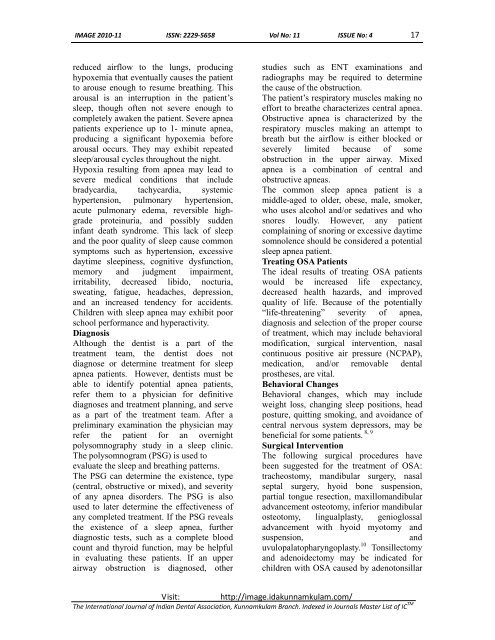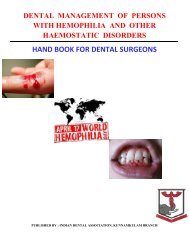'satisfactory smile' with a restorative approach - Indian Dental ...
'satisfactory smile' with a restorative approach - Indian Dental ...
'satisfactory smile' with a restorative approach - Indian Dental ...
You also want an ePaper? Increase the reach of your titles
YUMPU automatically turns print PDFs into web optimized ePapers that Google loves.
IMAGE 2010-11 ISSN: 2229-5658 Vol No: 11 ISSUE No: 4 17<br />
reduced airflow to the lungs, producing<br />
hypoxemia that eventually causes the patient<br />
to arouse enough to resume breathing. This<br />
arousal is an interruption in the patientís<br />
sleep, though often not severe enough to<br />
completely awaken the patient. Severe apnea<br />
patients experience up to 1- minute apnea,<br />
producing a significant hypoxemia before<br />
arousal occurs. They may exhibit repeated<br />
sleep/arousal cycles throughout the night.<br />
Hypoxia resulting from apnea may lead to<br />
severe medical conditions that include<br />
bradycardia, tachycardia, systemic<br />
hypertension, pulmonary hypertension,<br />
acute pulmonary edema, reversible highgrade<br />
proteinuria, and possibly sudden<br />
infant death syndrome. This lack of sleep<br />
and the poor quality of sleep cause common<br />
symptoms such as hypertension, excessive<br />
daytime sleepiness, cognitive dysfunction,<br />
memory and judgment impairment,<br />
irritability, decreased libido, nocturia,<br />
sweating, fatigue, headaches, depression,<br />
and an increased tendency for accidents.<br />
Children <strong>with</strong> sleep apnea may exhibit poor<br />
school performance and hyperactivity.<br />
Diagnosis<br />
Although the dentist is a part of the<br />
treatment team, the dentist does not<br />
diagnose or determine treatment for sleep<br />
apnea patients. However, dentists must be<br />
able to identify potential apnea patients,<br />
refer them to a physician for definitive<br />
diagnoses and treatment planning, and serve<br />
as a part of the treatment team. After a<br />
preliminary examination the physician may<br />
refer the patient for an overnight<br />
polysomnography study in a sleep clinic.<br />
The polysomnogram (PSG) is used to<br />
evaluate the sleep and breathing patterns.<br />
The PSG can determine the existence, type<br />
(central, obstructive or mixed), and severity<br />
of any apnea disorders. The PSG is also<br />
used to later determine the effectiveness of<br />
any completed treatment. If the PSG reveals<br />
the existence of a sleep apnea, further<br />
diagnostic tests, such as a complete blood<br />
count and thyroid function, may be helpful<br />
in evaluating these patients. If an upper<br />
airway obstruction is diagnosed, other<br />
studies such as ENT examinations and<br />
radiographs may be required to determine<br />
the cause of the obstruction.<br />
The patientís respiratory muscles making no<br />
effort to breathe characterizes central apnea.<br />
Obstructive apnea is characterized by the<br />
respiratory muscles making an attempt to<br />
breath but the airflow is either blocked or<br />
severely limited because of some<br />
obstruction in the upper airway. Mixed<br />
apnea is a combination of central and<br />
obstructive apneas.<br />
The common sleep apnea patient is a<br />
middle-aged to older, obese, male, smoker,<br />
who uses alcohol and/or sedatives and who<br />
snores loudly. However, any patient<br />
complaining of snoring or excessive daytime<br />
somnolence should be considered a potential<br />
sleep apnea patient.<br />
Treating OSA Patients<br />
The ideal results of treating OSA patients<br />
would be increased life expectancy,<br />
decreased health hazards, and improved<br />
quality of life. Because of the potentially<br />
ìlife-threateningî severity of apnea,<br />
diagnosis and selection of the proper course<br />
of treatment, which may include behavioral<br />
modification, surgical intervention, nasal<br />
continuous positive air pressure (NCPAP),<br />
medication, and/or removable dental<br />
prostheses, are vital.<br />
Behavioral Changes<br />
Behavioral changes, which may include<br />
weight loss, changing sleep positions, head<br />
posture, quitting smoking, and avoidance of<br />
central nervous system depressors, may be<br />
beneficial for some patients.<br />
Visit: http://image.idakunnamkulam.com/<br />
The International Journal of <strong>Indian</strong> <strong>Dental</strong> Association, Kunnamkulam Branch. Indexed in Journals Master List of IC TM<br />
8, 9<br />
Surgical Intervention<br />
The following surgical procedures have<br />
been suggested for the treatment of OSA:<br />
tracheostomy, mandibular surgery, nasal<br />
septal surgery, hyoid bone suspension,<br />
partial tongue resection, maxillomandibular<br />
advancement osteotomy, inferior mandibular<br />
osteotomy, lingualplasty, genioglossal<br />
advancement <strong>with</strong> hyoid myotomy and<br />
suspension, and<br />
uvulopalatopharyngoplasty. 10 Tonsillectomy<br />
and adenoidectomy may be indicated for<br />
children <strong>with</strong> OSA caused by adenotonsillar



